Humor
"Laugh-a-Palooza: Unleash Your Inner Chuckle!"
Rules
Read Full Rules Here!
Rule 1: Keep it light-hearted. This community is dedicated to humor and laughter, so let’s keep the tone light and positive.
Rule 2: Respectful Engagement. Keep it civil!
Rule 3: No spamming!
Rule 4: No explicit or NSFW content.
Rule 5: Stay on topic. Keep your posts relevant to humor-related topics.
Rule 6: Moderators Discretion. The moderators retain the right to remove any content, ban users/bots if deemed necessary.
Please report any violation of rules!
Warning: Strict compliance with all the rules is imperative. Failure to read and adhere to them will not be tolerated. Violations may result in immediate removal of your content and a permanent ban from the community.
We retain the discretion to modify the rules as we deem necessary.
view the rest of the comments

I'm honestly curious why the moon looks bigger to the naked eye than my phone camera.
Your eyes have a huge field of vision, but a very small field of true observation. As you read this comment, you can acknowledge there's a whole paragraph of text, but can only read 3-6 letters at a time. So while you can notice things in a ~180 degree field of view, you're only analyzing 1/2 degree at a time. Coincidentally, the moon is about 1/2 degree in apparent size. Your thumb nail is also about the same size at arm's length.
A camera, on the other hand, is taking a snapshot of an entire field of view. As you look through a photo, you're only analyzing the same 1/2 degree circle. If the photo is shrunk to fit, the moon is now much, much smaller than the original. If you zoom in on the pic to see the moon at the proper apparent size, you lose the other 99% of the picture - not unlike your actual useful view. Consider holding the phone up at arms length next to the moon as it shows the moon pic at life-scale. Your phone is effectively acting as a see through window - 6" wide and at arms length. See how little of the landscape is visible when actually scaled correctly? And even then, your phone is still about 15x wider than what your eyes can actually study at once. Hold your thumb out at arms length. Such a tiny amount of your field of view is obscured, yet it's probably slightly larger than whay you can observe.
So ultimately, it's not about special effects, lens compression, wide angle distortion, or anything like that. It's all about having 2 very different formats for viewing the world without realizing the fundamental differences.
PS: you may see people claim a 50mm lens on a full-frame camera is "what the human eye sees" regarding field of view. That's why it's used for portraits and favorable for some other close up photography. Yet, it's an awful combo for moon photography. It's field of view is about what people use to comfortably take in a whole object or scene. It will frame a portrait to about conversation distance and other objects to about where we would normally stand from an object of interest. Still, to observe it in detail, it needs to be displayed fairly large, like a whole computer screen. A 1080 phone at normal distance will look nice but won't quite match.